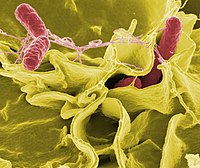
Photo from wikipedia
AIMS Formal depiction of granulomatous inflammation associated with renal neoplasms has mainly consisted of case reports. Herein, we investigate the clinicopathological features and potential significance of granulomas associated with renal… Click to show full abstract
AIMS Formal depiction of granulomatous inflammation associated with renal neoplasms has mainly consisted of case reports. Herein, we investigate the clinicopathological features and potential significance of granulomas associated with renal tumours from a large multi-institutional cohort. METHODS AND RESULTS One hundred and eleven study cases were collected from 22 institutions, including 57 partial nephrectomies and 54 radical nephrectomies. Patient ages ranged from 27 to 85 years (average = 60.1 years; male = 61%). Renal neoplasms included clear cell renal cell carcinoma (RCC; 86%), papillary RCC (8%), chromophobe RCC (3%), clear cell papillary RCC (1%), mixed epithelial stromal tumour (1%) and oncocytoma (1%). Granulomas were peritumoral in 36%, intratumoral in 24% and both in 40% of cases. Total granuloma count per case ranged from one to 300 (median = 15) with sizes ranging from 0.15 to 15 mm (mean = 1.9 mm). Necrotising granulomas were seen in 14% of cases. Histochemical stains for organisms were performed on 45% of cases (all negative). Sixteen cases (14%) had a prior biopsy/procedure performed, and eight patients had neoadjuvant immunotherapy or chemotherapy. Eleven patients (10%) had a confirmed diagnosis of sarcoidosis, including five in whom sarcoidosis was diagnosed after nephrectomy. CONCLUSION Based on this largest case-series to date, peri-/intratumoral granulomas associated with renal neoplasms may be more common than initially perceived. The extent of granulomatous inflammation can vary widely and may or may not have necrosis with possible aetiologies, including prior procedure or immunotherapy/chemotherapy. Although a clinical association with sarcoidosis is infrequent it can still occur, and the presence of granulomas warrants mention in pathology reports.
Journal Title: Histopathology
Year Published: 2022
Link to full text (if available)
Share on Social Media: Sign Up to like & get
recommendations!